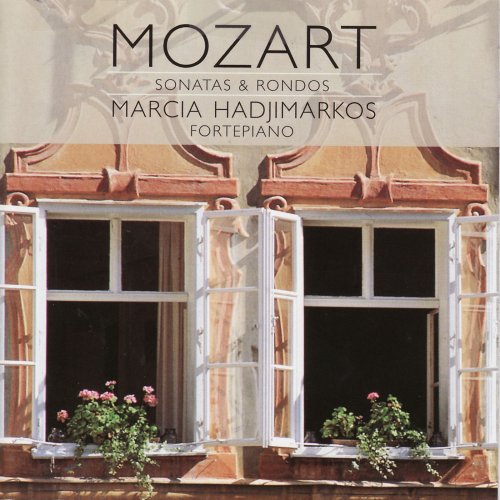
Marcia Hadjimarkos - Mozart: Three Sonatas and Three Rondos (2007)
BAND/ARTIST: Marcia Hadjimarkos
- Title: Mozart: Three Sonatas and Three Rondos
- Year Of Release: 2007
- Label: Avie
- Genre: Classical
- Quality: FLAC (tracks)
- Total Time: 01:16:21
- Total Size: 290 Mb
- WebSite: Album Preview
Tracklist:
Sonate pour piano en ut mineur, K 457 (Wolfgang Amadeus Mozart)
1 Sonata in C Minor, KV 457: I. Molto allegro 06:42
2 Sonata in C Minor, KV 457: II. Adagio 08:56
3 Sonata in C Minor, KV 457: III. Allegro assai 04:56
Rondo en fa majeur, K 494 (Wolfgang Amadeus Mozart)
4 Rondo in F Major, KV 494 07:10
Sonate pour piano en ut majeur, K 545 (Wolfgang Amadeus Mozart)
5 Sonata in C Major, KV 545: I. Allegro 03:37
6 Sonata in C Major, KV 545: II. Andante 05:15
7 Sonata in C Major, KV 545: III. Rondo (Allegretto) 01:51
Rondo en ré majeur, K 485 (Wolfgang Amadeus Mozart)
8 Rondo in D Major, KV 485 06:12
Sonate pour piano en si bémol majeur, K 333 (Wolfgang Amadeus Mozart)
9 Sonata in B Flat Major, KV 333 (315c): I. Allegro 08:02
10 Sonata in B Flat Major, KV 333 (315c): II. Andante cantabile 06:09
11 Sonata in B Flat Major, KV 333 (315c): III. Allegretto grazioso 06:54
Rondo en la mineur, K 511 (Wolfgang Amadeus Mozart)
12 Rondo in A Minor, KV 511 10:37
Performers:
Marcia Hadjimarkos (fortepiano)
Sonate pour piano en ut mineur, K 457 (Wolfgang Amadeus Mozart)
1 Sonata in C Minor, KV 457: I. Molto allegro 06:42
2 Sonata in C Minor, KV 457: II. Adagio 08:56
3 Sonata in C Minor, KV 457: III. Allegro assai 04:56
Rondo en fa majeur, K 494 (Wolfgang Amadeus Mozart)
4 Rondo in F Major, KV 494 07:10
Sonate pour piano en ut majeur, K 545 (Wolfgang Amadeus Mozart)
5 Sonata in C Major, KV 545: I. Allegro 03:37
6 Sonata in C Major, KV 545: II. Andante 05:15
7 Sonata in C Major, KV 545: III. Rondo (Allegretto) 01:51
Rondo en ré majeur, K 485 (Wolfgang Amadeus Mozart)
8 Rondo in D Major, KV 485 06:12
Sonate pour piano en si bémol majeur, K 333 (Wolfgang Amadeus Mozart)
9 Sonata in B Flat Major, KV 333 (315c): I. Allegro 08:02
10 Sonata in B Flat Major, KV 333 (315c): II. Andante cantabile 06:09
11 Sonata in B Flat Major, KV 333 (315c): III. Allegretto grazioso 06:54
Rondo en la mineur, K 511 (Wolfgang Amadeus Mozart)
12 Rondo in A Minor, KV 511 10:37
Performers:
Marcia Hadjimarkos (fortepiano)
The 1793 Sebastian Lengerer fortepiano used by American keyboardist Marcia Hadjimarkos on this disc is described in the booklet as "quieter but much more volatile" than the more common Anton Walter fortepianos of which it is a near contemporary. The "quieter but much more volatile" formulation might also apply to Hadjimarkos' playing itself, as compared with the general run of Mozart fortepiano recordings. She gives Mozart's music a uniquely improvisatory feel, and booklet annotator Brian Robins backs her up by pointing out that Mozart was well known in his own time as a keyboard performer. Hadjimarkos begins with the Piano Sonata in C minor, K. 457, unusually split off from the Fantasia in C minor, K. 475, with which it is usually paired. But the sonata in her hands takes on much of the brooding, Beethovenian character usually supplied by the prelude. Even more unusually, the Rondo in F major, K. 494, is presented alone, not as a finale to the incomplete Piano Sonata in F major, K. 533. The work's innocent opening theme is pushed into Schubert territory by Hadjimarkos' free treatment of the tempo. And so it goes, with varied results. Hadjimarkos puts the focus on the performer rather than the music, and she exploits the powers of the fortepiano fully in so doing. At times she perhaps pushes the music over the edge; the altered repeats in the Piano Sonata in C major, K. 545, do not sound particularly idiomatic, and the Rondo in A minor, K. 511, loses something of its exquisitely debilitated melancholy. But Hadjimarkos deserves full credit for conceiving and following through with a Mozart keyboard recording that's genuinely new.
As a ISRA.CLOUD's PREMIUM member you will have the following benefits:
- Unlimited high speed downloads
- Download directly without waiting time
- Unlimited parallel downloads
- Support for download accelerators
- No advertising
- Resume broken downloads


